1.10: Optimization
- Last updated
-
Nov 17, 2020
-
Save as PDF
-
Optimization problems, that is, problems in which we seek to find the greatest or smallest value of some quantity, are common in the applications of mathematics. Because of the extreme-value property, there is a straightforward algorithm for solving optimization problems involving continuous functions on closed and bounded intervals. Hence we will treat this case first before considering functions on other intervals.
Recall that if is the maximum, or minimum, value of on some interval and is differentiable at then Consequently, points at which the derivative vanishes will play an important role in our work on optimization.
Optimization on a Closed Interval
Suppose is a continuous function on a closed and bounded interval By the extreme-value property, attains a maximum, as well as a minimum value, on In particular, there is a real number in such that for all in If in and is differentiable at then we must have The only other possibilities are that is not differentiable at or similar comments hold for points at which a minimum value occurs.
Definition: singular points
We call a real number a singular point of a function if is defined on an open interval containing but is not differentiable at
Theorem
If is a continuous function on a closed and bounded interval then the maximum and minimum values of occur at either
- stationary points in the open interval \((a, b),
- singular point in the open interval or ( 3) the endpoints of
Hence we have the following procedure for optimizing a continuous function on an interval
- Find all stationary and singular points of in the open interval .
- Evaluate at all stationary and singular points of and at the endpoints and
- The maximum value of is the largest value found in step ( 2) and the minimum value of is the smallest value found in step
Example
Consider the function defined on the interval Then
and so when
For in the open interval this means that either
or
That is, the stationary points of in are and . Note that is differentiable at all points in and so there are no singular points of in Hence to identify the extreme values of we need evaluate only
and
Thus has a maximum value of 5.39724 at and a minimum value of at See Figure 1.10 .1 for the graph of on
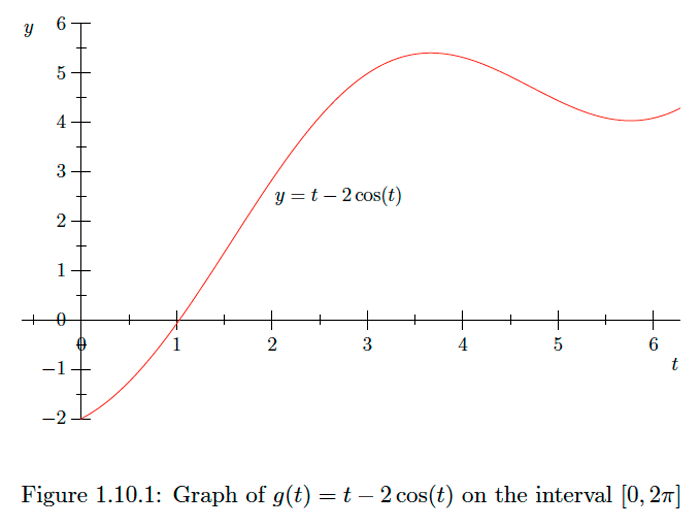
Exercise
Find the maximum and minimum values of
on the interval .
- Answer
-
Maximum value of 20 at minimum value of 12 at
Exercise
Find the maximum and minimum values of on the interval .
- Answer
-
Maximum value of 3.4840 at minimum value of at
Example
Suppose we inscribe a rectangle inside the ellipse with equation
as shown in Figure If we let be the coordinates of the upper right-hand corner of then the area of is
since is a point on the upper half of the ellipse, we have
and so
Now suppose we wish to find the dimensions of which maximize its area. That is, we want to find the maximum value of on the interval Now
Hence for in when that is, when Thus the maximum value of must occur at or Evaluating, we have
and
Hence the rectangle inscribed in with the largest area has area 16 when and That is, is by .
Exercise
Find the dimensions of the rectangle with largest area which may be inscribed in the ellipse with equation
where and are positive real numbers.
- Answer
-
is by
Exercise
A piece of wire, 100 centimeters in length, is cut into two pieces, one of which is used to form a square and the other a circle. Find the lengths of the pieces so that sum of the areas of the square and the circle are (a) maximum and (b) minimum.
- Answer
-
(a) all the wire is used for the circle;
(b) 43.99 cm use for the square, used for the circle
Exercise
Show that of all rectangles of a given perimeter the square is the one with the largest area
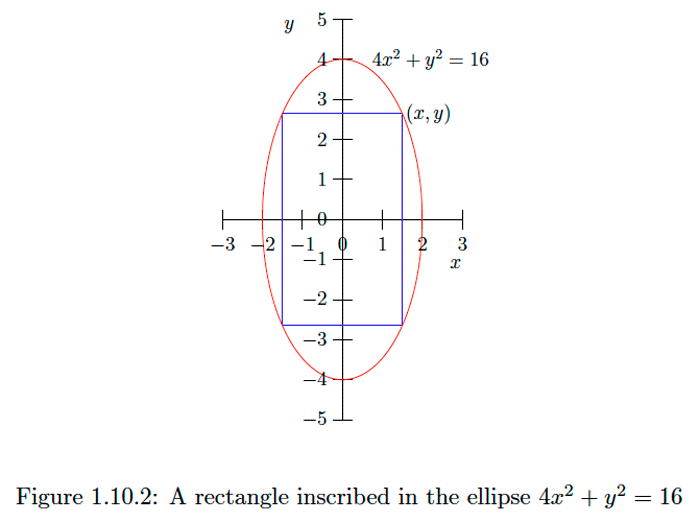
Optimization on Other Intervals
We now consider the case of a continuous function on an interval which is either not closed or not bounded. The extreme-value property does not apply in this case, and, as we have seen, we have no guarantee that has an extreme value on the interval. Hence, in general, this situation requires more careful analysis than that of the previous section.
However, there is one case which arises frequently and which is capable of a simple analysis. Suppose that is a point in which is either a stationary or singular point of and that is differentiable at all other points of . If for all in with and for all in with then is decreasing before and increasing after and so must have a minimum value at Similarly, if for all in with and for all in with then is increasing before and decreasing after and so must have a maximum value at The next examples will illustrate.
Example
Consider the problem of finding the extreme values of
on the interval Since
we see that when, and only when,
This is equivalent to
so on when, and only when, Similarly, we see that when, and only when, Thus is a decreasing function of on the interval and an increasing function of on the interval and so must have an minimum value at Note, however, that does not have a maximum value: given any if we may find a larger value for by using any and if we may find a larger value for by using any Thus we conclude that has a minimum value of 3 at but does not have a maximum value. See Figure
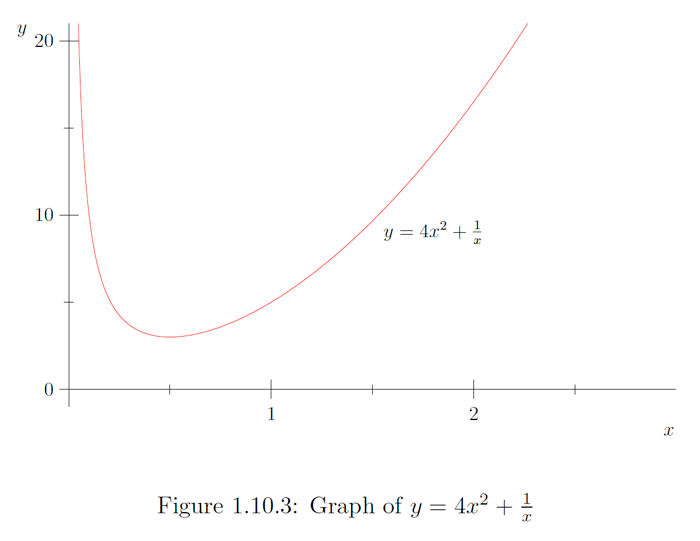
Example
Consider the problem of finding the shortest distance from the point to the parabola with equation If is a point on then the distance from to is
Our problem then is to find the minimum value of on the interval However, to make the problem somewhat easier to work with, we note that, since is always a positive value, finding the minimum value of is equivalent
to finding the minimum value of So letting
our problem becomes that of finding the minimum value of on Now
so when, and only when,
that is, when, and only when, or Now when and when whereas when and either when or when Taking the product of and we see that when and when and when and when It follows that is a decreasing function of on and on and is an increasing function of on and on .
It now follows that has a local minimum of at a local maximum of 1 at and another local minimum of at Note that is the minimum value of both on the the interval and on the interval since has a local maximum of 1 at it follows that is in fact the minimum value of on Hence we may conclude that the minimum distance from to is and the points on closest to are and Note, however, that does not have a maximum value, even though it has a local maximum value at See Figure 1.10 .5 for the graph of .
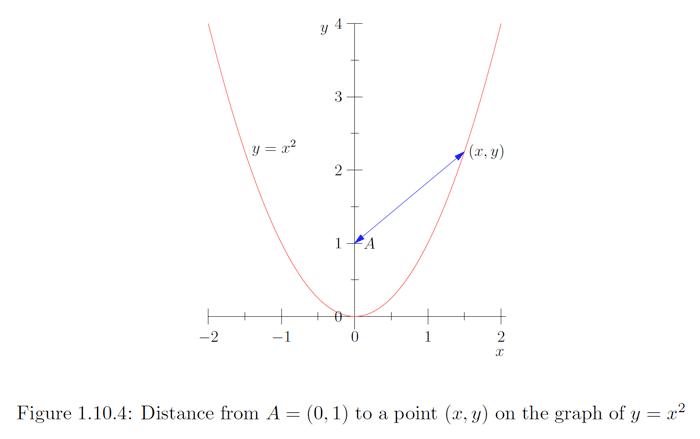
Exercise
Find the point on the parabola which is closest to the point .
- Answer
-
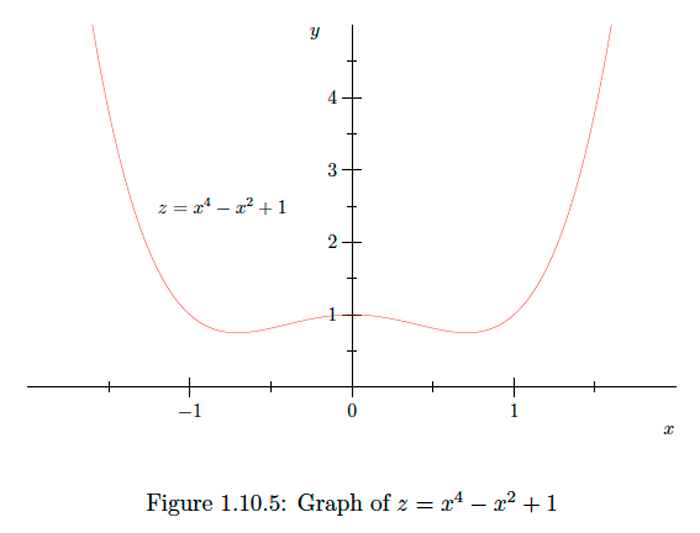
Exercise
Show that of all rectangles of a given area the square is the one with the shortest perimeter.
Exercise
Show that of all right circular cylinders with a fixed volume the one with height and diameter equal has the minimum surface area.
Exercise
Find the points on the ellipse which are closest to and (b) farthest from the point .
- Answer
-
(a) and (b)







